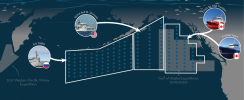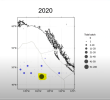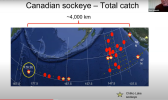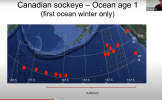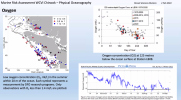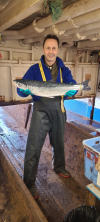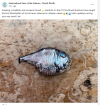NOAA Bell M. Shimada National Oceanic and Atmospheric Administration Overview The NOAA Ship Bell M. Shimada will be the U.S. research vessel contributing to the IYS 2022 Pan-Pacific Winter High Seas Expedition. The ship was commissioned in 2010 and is one of…

yearofthesalmon.org
February 26
We arrived on station at 50N, 151.5W shortly after midnight, and proceeded with our usual schedule of sampling. Jellyfish were very abundant near the surface at this station, so we did just a 30 minute tow to avoid ripping the net, and nonetheless caught a good pile of jellies, along with 4 sockeye and 1 chum salmon, our first of the trip.
The chum had a deformed head– the upper jaw was short, giving it a massive underbite. It also bore fresh wounds, evidence of a recent attack by a North Pacific daggertooth (Anotopterus nikparini).
After grabbing a bit of sleep, we arrived at 49N, 151.5W for our second of three stations for the day. Sea surface temperatures are now above 6C and there are more signs of life at the surface, with several Laysan albatrosses and a few puffins on the water. Our two-hour trawl caught 12 salmon– 10 chum, a pink and a sockeye.
The chum salmon looked thin, and had empty stomachs and enlarged gall bladders, suggesting they were struggling to find enough food. We are collecting samples to measure growth hormones when we return to land, which will tell us whether they are indeed growing slowly. Our plankton tows caught very little– a few large copepods and arrow worms, slim pickings for salmon.
We will head further south and sample at the 48S station this evening. Weather was Cloudy, calm winds, 12′ swell. Very early this morning we had some snow showers.
February 25
Last night we caught 7 sockeye at 52N, 147W, following a catch of three sockeye in the morning at 53N, 147W. Many of these fish again had enlarged, green gall bladders indicating poor feeding conditions, but the fish caught at night generally had stomachs stuffed with krill. It was too windy at these stations to effectively tow our plankton nets. Other things that have turned up in the trawl net include a juvenile prowfish, a lanternfish, and a few more lumpfish, along with the usual assortment of jellies and squid.
 yearofthesalmon.org
yearofthesalmon.org
